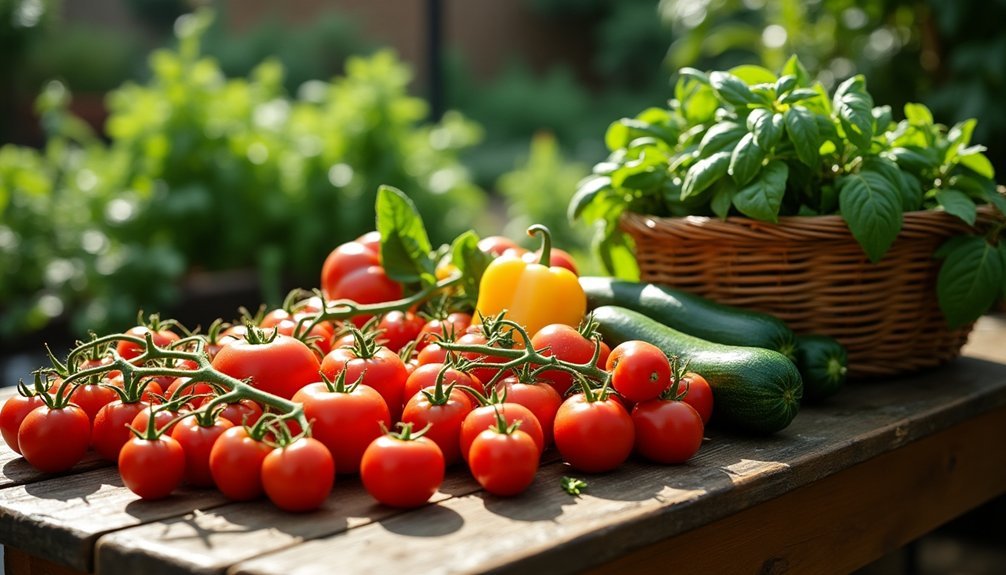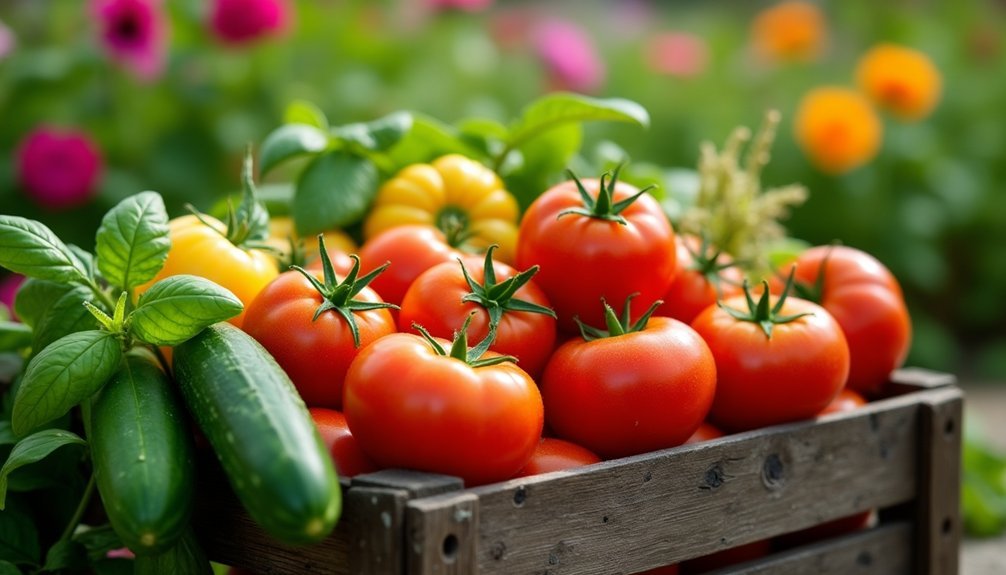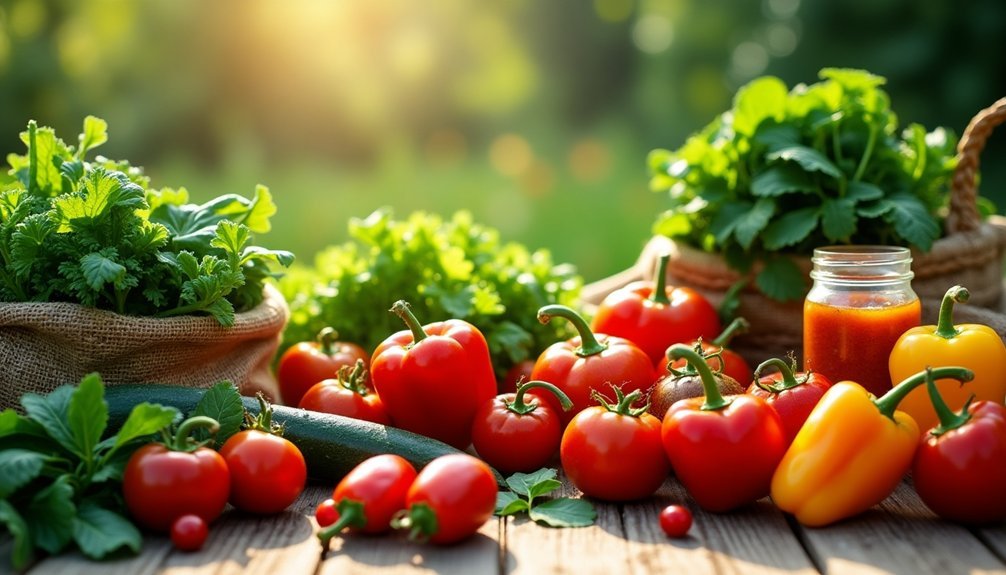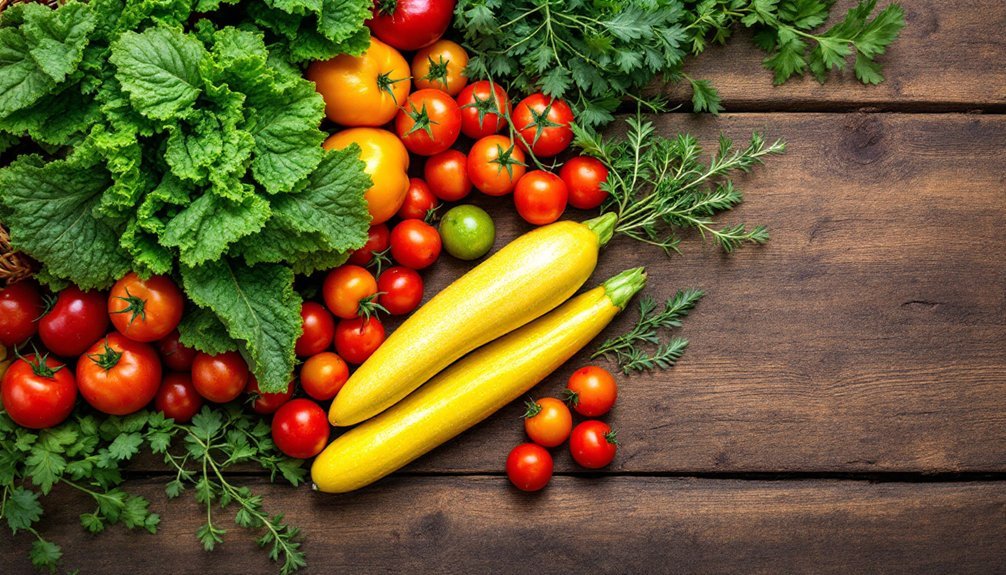Sharing garden surplus with neighbors tackles food waste while building stronger community connections. You'll create meaningful relationships when you exchange homegrown produce through neighborhood sharing tables or apps like GardenShare and Farmish. Set up a designated spot with clear guidelines, harvest early morning for freshness, and use social media to spread the word. Beyond reducing the 30-40% of food Americans typically waste, you'll experience the joy and fulfillment that comes from participating in your local gift economy.
The Growing Problem of Food Waste in Urban Communities

While millions struggle with hunger in our cities, an astonishing amount of food ends up in landfills daily.
You're living in a paradox: 150 million urban residents worldwide face food insecurity, yet cities generate 2.8 billion tons of organic waste annually.
In the US alone, nearly 35 million people don't have enough to eat, including 10 million children.
Meanwhile, Americans discard 30-40% of their food supply—worth $218 billion yearly. Your confusion over expiration dates likely contributes, as 80% of Americans throw away perfectly edible food due to label misunderstandings.
This waste isn't just economically wasteful; it's environmentally devastating.
Urban food waste creates methane emissions equivalent to 37 million cars on the road, affecting the very communities already struggling with food access. If considered a country, food waste would rank as the third largest greenhouse gas emitter globally.
Why Sharing Garden Surplus Strengthens Neighborhood Bonds
As community gardens bloom across urban landscapes, they cultivate far more than just vegetables and fruits—they grow relationships.
When you share your garden's excess harvest with neighbors, you're weaving social connections that extend beyond the garden fence. This simple act of giving transforms strangers into friends through shared purpose.
You'll notice how passing along tomatoes or zucchini creates natural opportunities for conversation and connection that mightn't occur otherwise. These exchanges build trust and reciprocity, strengthening your community's social fabric.
The collaborative nature of gardening—from swapping seeds to trading gardening tips—fosters belonging and civic pride. Participating in this gift economy creates deeper fulfillment than traditional monetary transactions ever could.
Your participation creates resilient neighborhoods where people look out for one another, transforming isolated urban spaces into vibrant communities united by shared bounty.
How to Identify Produce Ready for Sharing

Knowing when your garden produce is at its peak readiness guarantees you're sharing the best possible bounty with your neighbors.
For fruits, look for specific signs: apples should feel heavy and firm; tomatoes need vibrant color and slight give; and berries should have uniform color with no mushiness.
Remember that avocados, bananas, and mangoes continue ripening after picking—perfect for sharing before they're fully ripe. Mangoes are ready to eat when they have a fruity aroma at the stem end and yield slightly to gentle pressure.
When harvesting melons, tap them for a hollow sound and check for a yellow field spot on watermelons.
Citrus fruits should feel heavy for their size with vibrant color.
Use all your senses: vibrant colors indicate ripeness, sweet aromas signal peak flavor, and most ripe fruits yield slightly to gentle pressure without being mushy.
Properly timed harvesting guarantees your shared produce delivers maximum flavor and nutrition.
Setting Up a Successful Community Sharing Table
Setting up a community sharing table requires strategic placement where gardeners naturally gather, like near community gardens or farmers markets.
You'll need a few straightforward guidelines about drop-off times and food safety to keep things running smoothly. Consider using direct strategies when communicating these guidelines to save time and reduce frustration for participants.
Don't forget to create simple labels or cards for your donated produce so others can identify what you're sharing and how they might use it.
Location Is Everything
The perfect location for your community sharing table can make the difference between a thriving exchange hub and an overlooked spot that sits unused.
When scouting locations, prioritize areas with high foot traffic and easy accessibility for all community members, including those with disabilities.
Look for spots that are:
- Near community gathering places like parks, libraries, or farmers' markets
- Well-lit and visible from main pathways for safety and increased participation
- Protected from harsh weather conditions with optional coverings or shade
- Close to parking facilities or public transportation stops
Choose areas already known for community engagement to build on existing neighborhood connections.
Simple Rules Work
Successful community sharing tables depend on straightforward guidelines that everyone can understand and follow. Post clear signage describing acceptable items—fresh fruits and vegetables—and what to avoid. Encourage participants to package and label their contributions properly.
Establish basic hygiene practices like washing produce before sharing and using clean containers. Drawing from school programs, consider accepting only unopened, pre-packaged items and whole fruits to ensure safety. You'll need designated monitors to guarantee compliance with safety standards and manage the table's operation.
Create a simple feedback system so neighbors can suggest improvements. Consider implementing fair distribution policies to prevent one person from taking everything. Remember, the rules shouldn't be complicated—they should make sharing easier.
Partner with local food banks to redirect excess produce and reduce waste. When everyone knows what's expected, your sharing table will thrive as a community resource.
Communicate Your Bounty
Once your rules are in place, effective communication becomes the backbone of your sharing table's success.
Let your community know what's available and when through multiple channels to reach everyone interested in your garden bounty.
- Create a dedicated social media group where members can post daily harvest updates with vibrant photos of freshly picked vegetables.
- Maintain an email list for weekly newsletters highlighting upcoming harvests and special events.
- Set up a simple chalkboard or whiteboard at your garden entrance showing what's ready for sharing that day.
- Organize regular "harvest celebration" events where neighbors can see, taste, and learn about seasonal produce.
Don't underestimate word of mouth—encourage your regular participants to bring friends and spread the news through their personal networks. These personal connections will help distribute your excess zucchini and other abundant produce that might otherwise go to waste.
Digital Tools That Connect Garden Donors With Recipients
You'll find several innovative apps that transform how gardeners share excess produce with neighbors in need.
These digital platforms not only simplify the donation process but also allow you to track the impact of your garden contributions in real-time. Similar to how video messages can be tracked for donor analytics, these apps provide valuable insights into your community impact.
Neighborhood connectivity technology creates virtual communities where garden donors and recipients can coordinate pickups, share growing tips, and build relationships beyond the initial exchange of produce.
Apps Revolutionizing Produce Sharing
Digital technology has transformed the way gardeners share their surplus produce, with innovative apps creating seamless connections between those with extra harvests and those in need.
Apps like GardenShare, Farmish, CropSwap, and Locally Grown now make it easier than ever to participate in your local food economy.
Locally Grown is especially notable with its USDA backing through the Local Farm Promotion Program, validating its mission to connect gardeners with recipients.
These platforms offer:
- Map-based searches that pinpoint nearby garden bounty ready for pickup
- Direct messaging systems connecting you with neighborhood growers
- Collection site coordination for organized community donations
- Trading mechanisms allowing you to swap your extra tomatoes for someone's surplus zucchini
Whether you're looking to donate excess produce to food-insecure neighbors through GardenShare or trade homegrown vegetables via CropSwap, these tools help reduce food waste while strengthening community bonds.
Tracking Donation Impact
While apps connect gardeners with those who can use their surplus, tracking the impact of these donations has become increasingly sophisticated. You'll find digital tools like Donor Tools and Little Green Light help you monitor your garden-sharing contributions with real-time tracking.
These platforms offer efficient data entry and cost-effective solutions for neighborhood initiatives. You can visualize your community's progress with fundraising thermometers that celebrate milestones—whether it's pounds of tomatoes shared or families fed. Donor Tools captures all donation types including physical items like your harvested vegetables and fruits.
For coordinating larger neighborhood efforts, project management tools like Trello help assign tasks and track deadlines.
Want feedback? Survey tools like Google Forms collect recipient responses to improve your garden-sharing program. With personalized giving experiences through SmartLinks, you're not just donating produce—you're building relationships while measuring your genuine impact on food security.
Neighborhood Connectivity Technology
How have simple garden exchanges evolved into sophisticated digital ecosystems?
Today's garden sharing platforms leverage technology to connect you with neighbors looking to exchange produce. These digital tools transform isolated gardening efforts into interconnected community networks, making it easier than ever to share your harvest surplus. Platforms like Shared Earth function similarly to a dating site for gardeners and landowners seeking mutually beneficial relationships.
- Smart mapping systems visualize nearby gardens with surplus tomatoes, zucchini, or herbs within walking distance of your home.
- Real-time notification apps alert you when neighbors post freshly harvested produce available for pickup.
- QR-coded plant tags allow recipients to scan and learn about the growing practices used for their gifted produce.
- AI-powered matching algorithms connect gardeners with complementary growing patterns to maximize neighborhood variety.
You'll find these technologies are streamlining neighborhood food systems while building stronger community bonds.
Creating a Neighborhood Harvest Calendar
A neighborhood harvest calendar serves as the backbone of successful community growing efforts, allowing gardeners to coordinate plantings and maximize the diversity of shared produce.
You'll find this tool invaluable for tracking seasonal crops and ideal planting times specific to your local climate.
When you collaborate with neighbors on planning crop rotations, you'll better predict harvest times and quantities, making distribution more efficient.
Use your calendar to organize workshops on gardening techniques and food preservation methods, creating opportunities for knowledge sharing.
Community knowledge grows alongside our gardens when we gather to share what we've learned.
Consider incorporating digital tools like Seedtime for planning, or partner with local farmers to enhance your calendar's accuracy. Seedtime's Community feature connects neighbors through a private Facebook Group where you can share experiences and coordinate your neighborhood growing efforts.
Best Practices for Collecting and Storing Shared Produce

Once you've established your neighborhood harvest calendar, proper collection and storage techniques become critical to maintaining your garden bounty's quality and safety. Harvest early mornings when moisture content is highest, using clean, sanitized tools to prevent contamination.
After collection, follow these essential practices:
- Wash your hands thoroughly and wear gloves when handling produce to prevent contamination.
- Gently clean and dry items before storing them in food-grade containers with proper air circulation.
- Store perishables in cool, shaded areas and refrigerate when necessary to extend freshness.
- Label all packaging clearly with contents and handling instructions, encouraging reusable containers.
When transporting shared produce, keep items secure and shaded, minimizing travel time to preserve quality. Consider including educational newsletters that provide care tips and information about less familiar vegetables to help recipients make the most of their shared produce.
Regularly inspect stored items and remove any showing signs of spoilage.
The Health Impact of Fresh Local Produce Access
The profound health impact of fresh local produce extends far beyond just adding color to your plate. When you eat locally grown fruits and vegetables, you're consuming food that's fresher, more nutrient-dense, and often contains fewer chemical preservatives. Fresh produce from local sources rapidly loses vital nutrients within 24 hours after being harvested.
| Health Benefit | Why It Matters | Community Impact |
|---|---|---|
| Higher nutrient content | Picked at peak ripeness | Reduces food insecurity |
| Diverse antioxidants | Supports immune function | Improves community health |
| Less chemical exposure | Healthier food system | Supports sustainable farming |
Access to local produce has been linked to improved dietary habits and reduced rates of diet-related diseases. Programs like the Fruit and Vegetable Prescription initiative leverage these benefits to create measurable health improvements. You'll also benefit mentally—participating in gardening activities associated with local food systems can enhance both physical and psychological wellbeing.
Stories From Successful Urban Garden Sharing Networks
Successful urban garden sharing networks around the world demonstrate how community-driven initiatives can transform city landscapes into productive green spaces.
You'll find inspiration in Havana's 200+ urban farms that emerged from food shortages, and Detroit's transformation of vacant lots into productive gardens offering CSA services and economic opportunities.
- London's FARM:shop – Picture a vibrant hub where small-scale farming meets social spaces, proving urban agriculture's viability.
- Lahti's community plots – Imagine rentable garden boxes where residents use mobile apps to manage their growing vegetables. The collaborative effort between three stakeholders – Lahden Talot, Blockgarden, and youth group Inspis – shows how different organizations can unite to create sustainable urban farming initiatives.
- Singapore's vertical gardens – Envision innovative farming techniques rising skyward, improving air quality while using minimal space.
- Paris' green rooftops – Visualize rooftop farms countering urban heat while providing fresh local produce.
Overcoming Barriers to Community Food Sharing
You'll find that digital platforms can connect gardeners with neighbors who lack transportation to community gardens or food banks.
Building face-to-face relationships in your community creates the trust needed to overcome stigma associated with food sharing.
When you organize neighborhood carpools or delivery volunteers, you're directly addressing one of the most persistent barriers to equitable food distribution.
Consider how different communities have unique cultural core concepts that determine which local food practices are valued and sustained within neighborhood sharing networks.
Tech Bridges Access Gaps
While traditional food sharing faces barriers like distance and accessibility, innovative technology platforms now connect gardeners, businesses, and neighbors in ways that overcome these limitations.
You're now empowered to share your garden's abundance through user-friendly apps designed with simplicity in mind.
These tech solutions bridge access gaps through:
- Location-based services that match your excess produce with nearby neighbors who can pick up within walking distance
- Multilingual interfaces making participation possible across diverse communities regardless of language barriers
- Free mobile platforms requiring only basic smartphone skills to connect food donors with recipients
- Volunteer networks coordinated through apps that handle collection and delivery when transportation is an issue
These digital initiatives help reduce the 8-10% of global GHG emissions caused annually by food waste while creating stronger community bonds.
Building Trust Locally
Building a community food sharing network requires more than just technology—it demands authentic relationships and trust among neighbors.
You'll find that shared meals create deeper connections, especially in diverse communities where culturally relevant foods matter tremendously.
Start by engaging your community through local meetings where you can identify specific barriers to food sharing.
Listen carefully to concerns about safety practices and accessibility, as these often prevent participation.
When organizing food exchanges, guarantee clear information about where, when, and who's eligible to participate.
Partner with trusted local organizations that already have established relationships in your neighborhood.
They can help overcome language barriers and cultural differences.
Food insecurity disproportionately impacts racial and ethnic minorities, making inclusive community food sharing initiatives particularly important.
Remember that community feedback is essential—what works in one neighborhood may not work in yours.
Ultimately, successful food sharing depends on neighbors feeling welcome and respected.
Transport Solutions Matter
Transportation barriers often remain the invisible obstacle in community food sharing networks, preventing neighbors from accessing or contributing to local bounty.
You'll find that solving these challenges creates pathways for food to flow freely throughout your community.
Consider implementing these neighborhood-friendly options:
- Organize a volunteer driver network where car owners commit to one delivery day per month.
- Create neighborhood pickup hubs in centrally located areas like community centers or schools.
- Establish a bike-delivery brigade using cargo bikes for short-distance produce transport.
- Develop a shared ride system coordinated through a simple text message group.
When you remove transportation barriers, you're not just moving food—you're building connections that strengthen your community's food resilience and independence. These community-driven solutions are especially important as Minnesota ranks among the worst states for residents with low access to healthy foods.
Building Sustainable Food Sharing Systems for Year-Round Access
Sustainable food sharing systems require thoughtful infrastructure to provide consistent access throughout the year, not just during peak growing seasons.
You'll find closed-loop systems particularly effective, as they optimize resource usage while minimizing waste in your local food supply chain.
Consider integrating digital platforms like FoodCloud to efficiently connect surplus producers with those who need food.
These tools can map available resources and coordinate distribution even during winter months. Implementing preservation techniques such as fermentation extends your sharing potential beyond harvest periods.
Don't underestimate the power of community infrastructure—social dining events and skill-sharing workshops can maintain momentum when gardens aren't producing. The Cultivate project has developed a Digital Food Sharing Compass to help communities track and monitor their food sharing initiatives.
Frequently Asked Questions
Can I Claim Tax Deductions for My Garden Produce Donations?
You can claim tax deductions for garden produce donations to 501(c)(3) organizations. You'll need documentation of weight and fair market value. Deductions depend on your tax situation and business status.
How Do I Address Food Safety Concerns With Shared Garden Produce?
To address food safety concerns with shared garden produce, you'll need to test soil, practice good hand hygiene, sanitize tools, document your methods, and follow proper harvesting techniques to prevent contamination risks.
Are There Liability Issues When Sharing Homegrown Food?
Yes, you face liability risks when sharing homegrown food if recipients get sick. Good Samaritan protections typically don't cover direct person-to-person sharing, only donations to nonprofits. Your homeowner's insurance might provide some coverage.
What Vegetables Are Most Needed by Food Banks?
Food banks most need nutrient-dense, durable vegetables like carrots, potatoes, onions, winter squash, and sweet potatoes. You'll make the biggest impact by donating these staples that store well and offer substantial nutrition.
Can Garden Sharing Programs Work in Apartment Communities?
Yes, garden sharing programs thrive in apartment communities. You'll build relationships with neighbors, save money, and enjoy fresh produce. Start with raised beds or container gardens to overcome space limitations and follow community guidelines.
In Summary
Whether you're sharing a single zucchini or organizing a neighborhood harvest exchange, you're building something far greater than a food distribution system. You're creating connections, reducing waste, and improving health in your community. Don't let your garden abundance go unused when neighbors might benefit. Start small, expand thoughtfully, and watch how shared harvests transform your neighborhood into a more resilient, connected community.





Leave a Reply